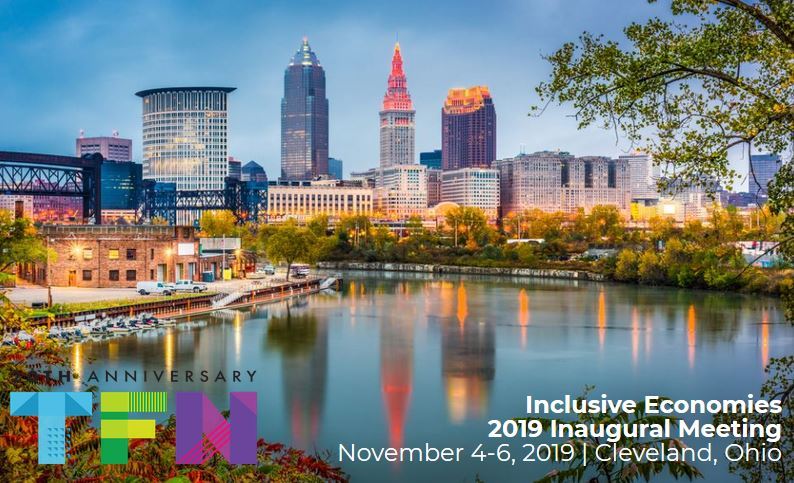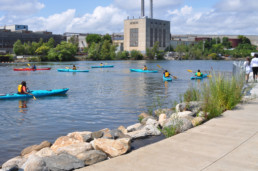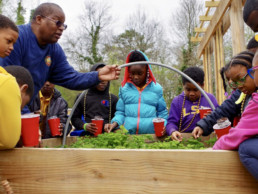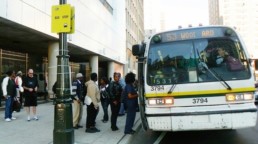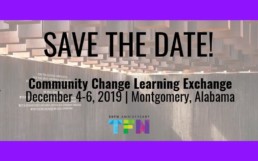Sustainability Grant Opportunity: Partners for Places Round 16 RFP
By TFN Staff
The Funders’ Network (TFN), in partnership with the Urban Sustainability Directors Network, is pleased to announce the opening of Round 16 of the Partners for Places grant program.
Partners for Places is a successful matching grant program that improves U.S. and Canadian communities by building partnerships between local government sustainability leaders and place-based foundations. National funders invest in local projects developed through these partnerships to promote a healthy environment, a strong economy and well-being for all residents. Through these investments, Partners for Places fosters long-term relationships that make our communities more prosperous, livable and vibrant.
In addition to the general grant program, Round 16 also includes dedicated funding to support green stormwater infrastructure projects that advance water-related sustainability goals.
To date, Partners for Places has awarded more than $7 million across North America in this successful matching grant program. Matching local funders have contributed in excess of $8 million, leading to more than more than $15 million in investments.
TFN and USDN are excited to partner once again with Green Infrastructure Leadership Exchange, a practitioner network that supports communities seeking to grow green stormwater infrastructure programs, to support outreach efforts and participate in reviewing stormwater infrastructure project proposals.
The grant program provides partnership investments between $25,000 and $75,000 for one-year projects, or between $50,000 and $100,000 for two-year projects, with a 1:1 match required by one or more local foundations.

Creating a Successful Proposal
Partners for Places accepts proposals for the creation of a community-focused sustainability, climate action, adaptation/resilience, equity, water or comprehensive plan that specifically addresses sustainability; or urban sustainability and/or green stormwater infrastructure. If your proposal requests funding for the creation of one of these plans, please closely review our Proposal and Award Guidance document before preparing your proposal.
In addition, all proposals are scored on the extent to which projects include meaningful involvement of priority audiences/stakeholders in program development and implementation.
The application deadline for Round 16 is January 31, 2020 (by 11:59 p.m., any time zone).
Please visit the Partners for Places webpage for more information. Here you can view our promotional video, download the Request for Proposals (RFP), and access our Proposal Form and Budget Form. You may also consult our Proposal and Award Guidance document to learn more about frequently asked questions.
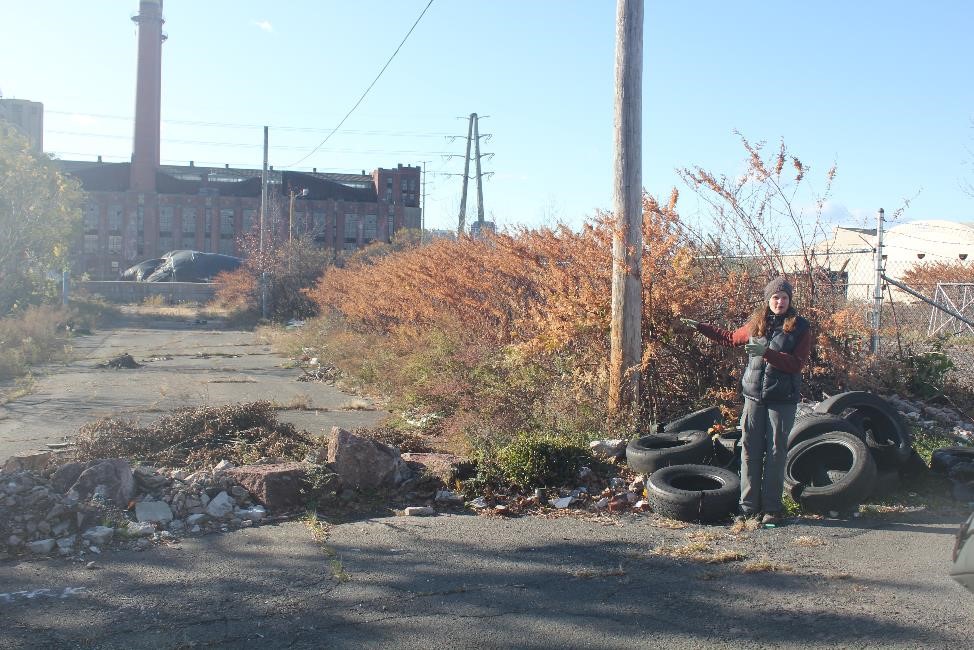
Additional Resources
Info Webinar
TFN will host a webinar to answer any questions about the grant program on Dec. 10, at 2 p.m. ET. Please register for the webinar here. A recording of the webinar will be made available upon request for those of you unable to participate. (Please email Ashley Quintana at ashley@www.fundersnetwork.org.
Meet the Newest Grantees!
We recently announced the Round 15 grantees of the Partners for Places matching grant program: Six communities across the U.S. will receive funding for sustainability efforts that will help them better withstand the impact of climate change, strengthen local economies and improve the well-being of all residents. Read more about our newest grantees here.
Funder Investors
Partners for Places general grant program is supported by The JPB Foundation, Kendeda Fund, The Kresge Foundation, New York Community Trust, the Pisces Foundation, The Summit Foundation, and Surdna Foundation.
Selection Process
A selection committee comprised of foundation representatives and urban sustainability directors will make grant selection decisions on behalf of Partners for Places, and awards will be announced in May 2020.
If the RFP and the Proposal and Award Guidance documents don’t answer all your questions, please contact Ashley Quintana at ashley@www.fundersnetwork.org for more information.
Partners for Places: Meet our New Grantees!
By Tere Figueras Negrete, Director of Communications
Neighborhood gardens and an urban food forest that will produce fruits, herbs and vegetables for low-income communities. Vibrant and sustainable public spaces brought to life by transforming an abandoned roadway and an under-used local waterfront. Affordable housing that is able to weather extreme storms and climate-related disasters, and homeowners equipped with the skills to ensure homes are energy efficient and free of highly toxic lead.
These community-based approaches that address climate impacts, strengthen local economies and improve the well-being of all residents are the latest round of projects that will receive funding thanks to the Partners for Places matching grant program.
Six U.S. cities will receive $853,000 to support these sustainability efforts — which focus largely on empowering and engaging low-income neighborhoods and building partnerships between government sustainability offices and place-based foundations.
Atlanta, Ga., is creating the city’s first publicly owned food forest in an underserved community deemed a “food desert” because of a lack of access to fresh produce. The grant will be used to support education and volunteer programs at the seven-acre food forest located on one of the last remaining farmsteads in the area. The funding for the Urban Food Forest at Brown Mills will help establish volunteer and educational programs that encourage people to learn more about how food is produced and help foster a connection to the cultural and social history of the community.
In Philadelphia, Pa., the Partners for Places grant will support efforts to create a citywide urban agriculture plan to ensure all Philadelphians have access to fresh, healthy and affordable food. The coordinated approach is designed to further encourage urban agriculture, especially in disinvested areas where neighbors have transformed hundreds of vacant or under-used spaces into gardens that are often at risk of being lost due to development, lack of funding, and other issues.
Boston, Mass., where a significant proportion of housing is located in physically vulnerable areas such as floodplains, will support efforts to ensure the homes of some of the city’s most socially and economically underserved residents are ready to withstand future climate shocks. This includes plans to offer emergency preparedness planning and resiliency audits for owners and managers of affordable multi-family housing, helping them better protect properties and residents from the impacts of extreme storms, high temperatures and other climate-related disasters.
In Detroit, Mich., limited-income homeowners will be better able to address lead hazards, energy and water inefficiency and other home repair needs. Homeowners and their family members will go through a hands-on workshop series to acquire basic home renovation and repair skills, as well as training to safely remove lead or safely repair homes where lead may be present. Participants will receive lead-safe work supplies, weatherization supplies, access to a tool share for their renovation projects and the opportunity to be mentored by experienced contractors to reinforce class learnings.
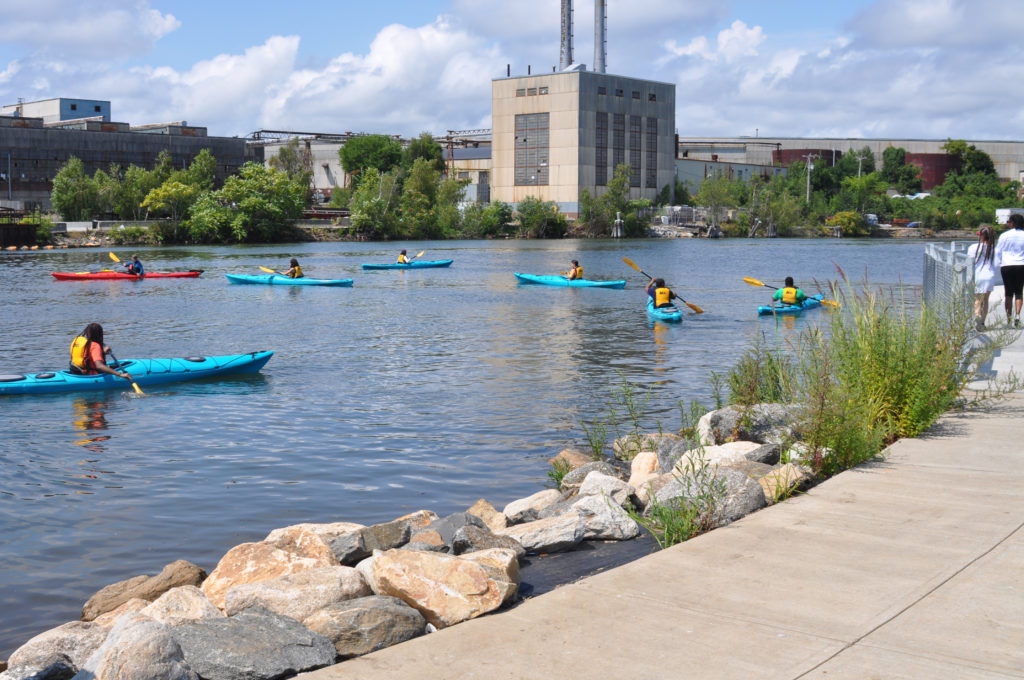
Two Connecticut communities will receive funding for green stormwater infrastructure projects designed to advance water-related sustainability goals.
An abandoned roadway in New Haven, Conn., will be turned into a community greenspace with green infrastructure connecting an urban community to parkland and the nearby Mill River. The project, which is located in an underserved community where access to the shore and greenspace have been sacrificed to industrial use, will convert the unused roadway into a “parklet” consisting of a multi-purpose trail and a series of native pollinator gardens and bioretention areas that will divert more than two million gallons of stormwater from New Haven’s combined sewer system each year. In Bridgeport, Conn., where a majority of the city’s waterfront areas are underused or inaccessible to the public, community stakeholders will work to build an equitable and sustainable waterfront that incorporates green infrastructure and resiliency features. Partners for Places funding will be used to support a community-based effort to plan, design, and create a waterfront pathway that traces Long Island Sound and several rivers.
Partners for Places, led by the Funders’ Network for Smart Growth and Livable Communities in partnership with the Urban Sustainability Directors Network, will provide $372,500 in funding to these six cities through the grant program. With contributions from local matching funders, a total of $853,000 will be committed to fund sustainability projects in these selected cities. This grant cycle includes $112,500 awarded to two green stormwater infrastructure projects — in the cities of Bridgeport and New Haven — designed to advance water-related sustainability goals.
The Partners for Places matching grants program has helped foster dozens of new partnerships between local government sustainability leaders and place-based funders across the U.S. and Canada over the past eight years. The matching grant program brings national funder investors together with place-based funders to support local sustainability and climate action projects. The program is supported by seven investor foundations: The JPB Foundation, The Kendeda Fund, The Kresge Foundation, The New York Community Trust, Pisces Foundation, The Summit Foundation, and Surdna Foundation.
“Communities across the U.S. and Canada are coming together to tackle the impacts of climate change with innovative projects that are making a difference in people’s lives, especially those in greatest need,” said Diane Ives, fund advisor for The Kendeda Fund’s People, Place and Planet program. “These partnerships foster long-term relationships that in turn help communities become more sustainable, equitable and prosperous places.”
To date, Partners for Places has awarded more than $7 million across North America in this successful matching grant program. Matching local funders have contributed in excess of $8 million, leading to more than more than $15 million in investments.
Partners for Places will open a new round of funding for the general grant program on Dec. 5, 2019. The Round 16 RFP will be due Jan. 31, 2020. If you have any questions about the Partners for Places grant program, please reach out to Ashley Quintana at ashley@www.fundersnetwork.org.
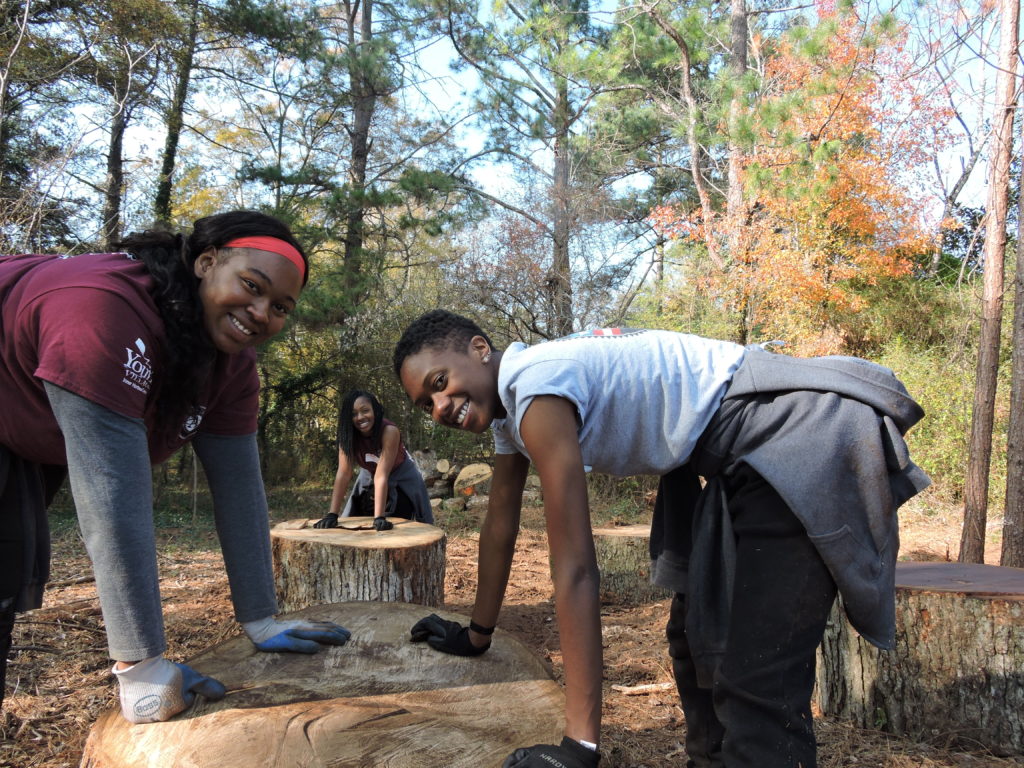
The latest Partners for Places grant recipients and their matching funders are:
- Atlanta, Ga. ($35,000): To create the nation’s largest and Atlanta’s first publicly-owned food forest to deliver environmental, economic, and social justice outcomes for the local community. Matching funder: Turner Foundation ($35,000).
- Boston, Mass. ($50,000): To ensure vulnerable multi-family affordable housing, which is home to some of Boston’s most socially and economically underserved residents, is ready to withstand future climate shocks. Matching funder: Local Initiatives Support Corporation (LISC) Boston ($50,000).
- Bridgeport, Conn. (72,500): To build an equitable and sustainable Bridgeport Waterfront and support a community-based vision to address climate impacts, strengthen local economies, and improve the well-being of all residents. Matching funders: Jeniam Foundation ($32,500); Long Island Sound Funders Collaborative ($40,000).
- Detroit, Mich. ($100,000): To address intersectional housing issues by empowering and equipping limited income homeowners to address lead hazards, energy inefficacy, and other home repair needs. Matching funder: The Fred A. and Barbara M. Erb Family Foundation ($100,000).
- New Haven, Conn. ($40,000): To transform an abandoned roadway, in an underserved community, into a community greenspace with green infrastructure connecting an urban community to parkland and the river. Matching funders: The Community Foundation for Greater New Haven ($30,000); The Watershed Fund ($10,000).
- Philadelphia, Pa. ($75,000): To develop a comprehensive citywide urban agriculture plan that will guide the coordinated efforts of city, non-profit, and resident stakeholders to better protect, maintain, and expand community gardens, farms, and orchards. Matching funder: William Penn Foundation ($150,000).
About Partners for Places Partners for Places
A joint project of the Funders’ Network for Smart Growth and Livable Communities and the Urban Sustainability Directors Network, Partners for Places is a successful matching grant program that improves U.S. and Canadian communities by building partnerships between local government sustainability leaders and place-based foundations. National funders invest in local projects developed through these partnerships to promote a healthy environment, a strong economy and well-being for all residents. Through these investments, Partners for Places fosters long-term relationships that make our communities more prosperous, livable and vibrant. For more information on Partners for Places, visit www.fundersnetwork.org/partners-for-places/
About the Funders’ Network for Smart Growth and Livable Communities
The Funders’ Network for Smart Growth and Livable Communities (TFN) is a mission-driven network of grantmakers across North America, working to inspire, strengthen and expand funding and philanthropic leadership that yield environmentally sustainable, socially equitable, and economically prosperous regions and communities.
About The Urban Sustainability Directors Network
The Urban Sustainability Directors Network (USDN) is a peer-to-peer network of local government professionals from cities across the United States and Canada dedicated to creating a healthier environment, economic prosperity, and increased social equity. Our dynamic network enables sustainability directors and staff to share best practices and accelerate the application of good ideas across North America.

Below: An artist's rendering of the Mill River Trail.
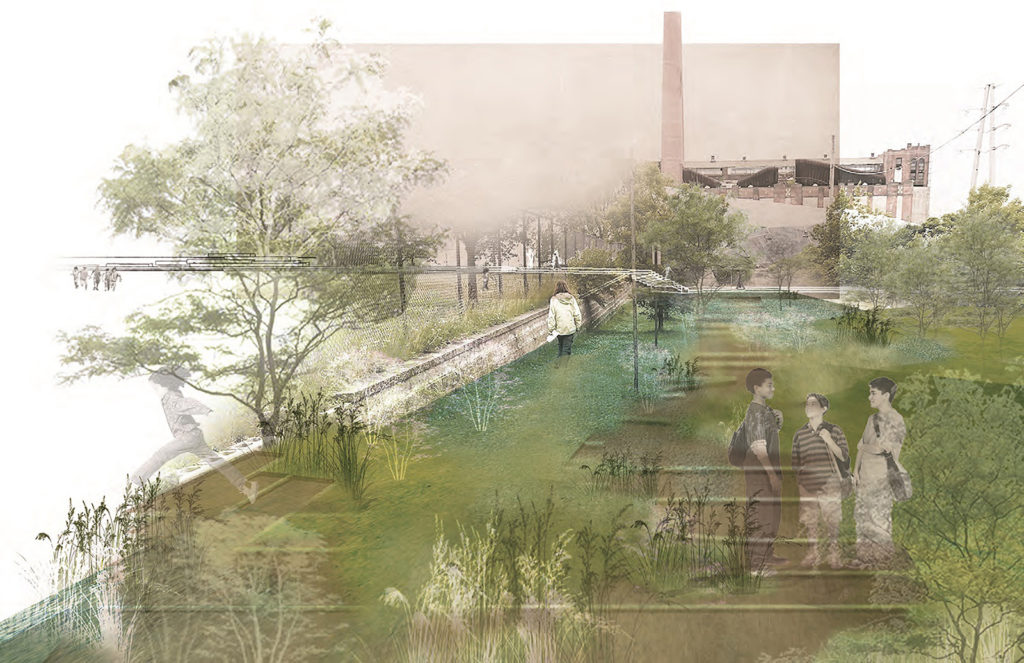
For additional information and media inquiries, contact: Tere Figueras Negrete, Communications Director at the Funders’ Network for Smart Growth and Livable Communities at tere@www.fundersnetwork.org

Going PLACES: Pride, gratitude and Hope in El Paso
By Denise Herrera, PhD, Senior Capacity Building Officer, St. David’s Foundation and PLACES 2019 Fellow
Going PLACES is an occasional blog series featuring the voices and experiences of TFN’s PLACES Fellows. For more information on the fellowship, and to read past blog posts from our fellows, visit here.

I grew up three and a half hours north of El Paso, so I was excited to visit a neighboring community I haven’t experienced since childhood. When I think of El Paso, I think of familia, resilience, community, traditions, culture, and food OMG — ALL THE DELICIOUS FOODS! I think about the growing relationships I’ve developed with Paso del Norte Health Foundation, which was kind enough to host a portion of our site visit. I’m intrigued that they serve about 2.4 million people across two countries (the U.S. and Mexico) and three states (Texas, New Mexico, and the Mexican state of Chihuahua).
The first question our TFN PLACES coach, Bina Patel, asked upon our arrival was, “What’s in your backpack? What are you carrying and what are you feeling?” I wrote in my journal feelings of immense pride, gratitude, and hope – particularly hopeful that community resilience and strong culture would prevail even in the darkest of political times. After all, family ties are much stronger than political ties, que no? It has been said that El Paso is the new Ellis Island of the Southwest, where people mobilize and move in every direction to pursue a better life. My PLACES cohort and I also (literally) had in our own “backpacks” hundreds of pairs of shoelaces, backpacks, and other supplies for immigrant families and asylum seekers. As families reach the U.S.-Mexico border, shoelaces are the first item confiscated, so individuals cannot run or cause self harm when in a detention or asylum center.
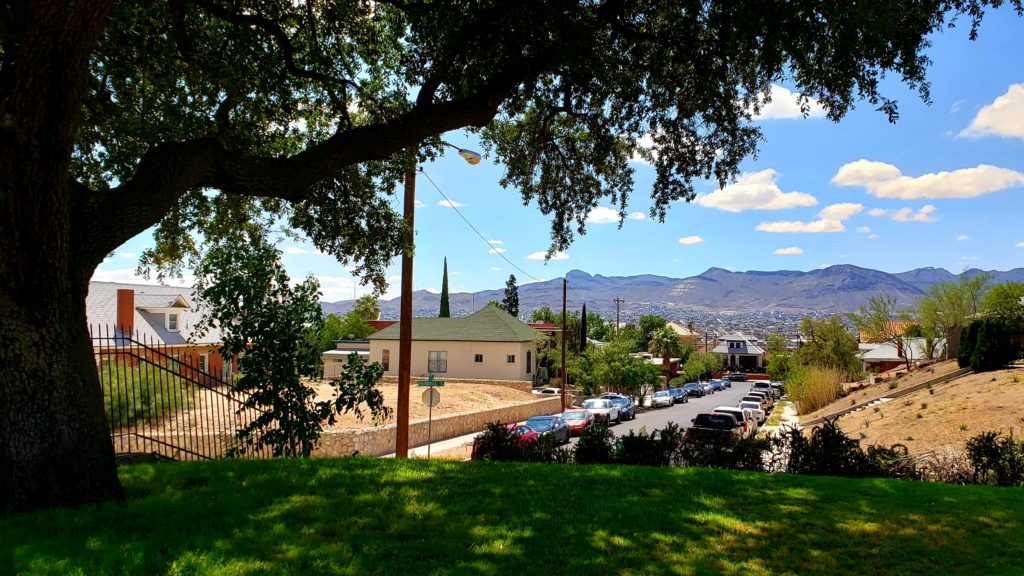
I also arrived believing that human beings created inequitable systems and institutions that don’t often allow immigrant families or communities of color to thrive. And I left trusting that if human beings have the capacity to create such unjust and broken systems, we can also dismantle them if we work together rather than in silos. As the honorable Bryan Stevenson would suggest, “We have a system of justice [in the U.S.] that treats you much better if you’re rich and guilty than if you’re poor and innocent. Wealth, not culpability, shapes outcomes. We all have a responsibility to create a just society.”
I have the honor of working toward social justice and health equity every single day. Being in the philanthropic sector is one of my life’s greatest privileges. There’s less red tape and bureaucracy in philanthropy compared to the federal government, academic institutions, and other sectors. If I’ve ever done significant soul-searching and questioned my life’s purpose, it’s happening right now. Congratulations for being part of my journey and free-flowing reflections.
Day 1. We had the pleasure of visiting the El Paso County Historical Society , developed in 1954 with support from the Women’s Department of the Chamber of Commerce. “El Paso is a crossroads, where millions of people have moved around, in and out, in all directions,” according to a professor from the University of Texas-El Paso. With the copper industry booming, the El Paso and Southwestern Railroad (formerly known as the South Eastern Railroad) was developed in 1888 and operated in Arizona, New Mexico and Texas, with extensions into Mexico. With the railroad came new jobs, a more diverse military, and a strong sense of community. People have traditionally felt safe and welcome in El Paso and don’t want to leave. From 2016 to 2018, El Paso was ranked among the top four safest U.S. cities per capita and for its size; from 2009 to 2018, El Paso averaged 16 murders a year. As one of our hosts eloquently stated, “There’s more crime in the White House than in El Paso.” Word.
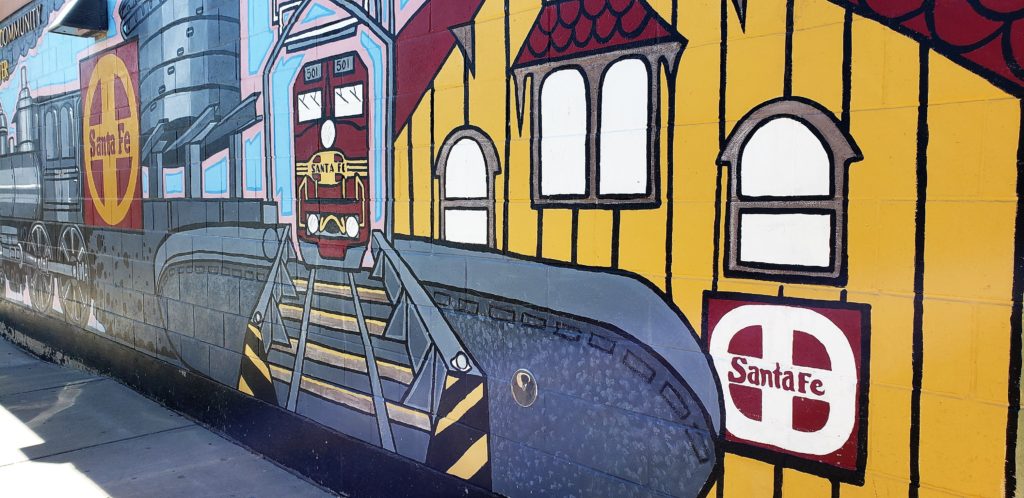
I left the Historical Society with a better appreciation for how tough decisions are made regarding documenting important stories, such as the many lives lost due to the senseless act of domestic terrorism on Aug. 3, 2019. Without glorifying the event, it’s the Historical Society’s job to preserve and archive stories — such as vigils and memorials — so current and future generations learn from this horror so it never happens again.
The Historical Society also preserves stories of triumph, such as the tale of the 1966 NCAA basketball championship that inspired the movie Glory Road. The cultural impact of Texas Western’s win over Kentucky is still felt more than five decades later. For the first time in U.S. history, the lineup featured all black starters against all white starters. The Texas Western Miners (now University of Texas-El Paso) came out victorious, earning the only NCAA championship title (so far) for the state of Texas.
Day 2. When Executive Director Fernando Garcia walked in sporting a custom designed “El Paso Firme: Action Against White Supremacy” shirt, I knew we were in for some refreshing truth-telling. The Border Network for Human Rights has trained dignity and human rights leaders and promoters since 1998, working toward community orientation and immigrant enforcement accountability. Through the network, immigrant families are educated on their human rights and the U.S. Constitution. The network undoubtedly stands for eliminating crime and human trafficking, and also aims to demolish the criminalization of families and immigrants. Remember how I mentioned resilience and community before? Check out how the El Paso and neighboring communities banded together to bring healing and solidarity three days before our arrival. Graffiti artist Gabe Rael’s mural tribute is among the most inspiring visualizations I’ve ever witnessed. The rose at the top symbolizes what people take to a funeral —and this mural is the “rose” Gabe had to offer to his beloved community.
When I returned to my hotel room, I realized some interesting parallels to philanthropy. After two days of visiting U.S. Border Patrol agents, an asylum center, the Historical Center, and various local foundations, the irony is still unsettling. After speaking with Border Patrol agents, many of my colleagues were infuriated, disgruntled, and appalled by many things we heard — including when one agent mentioned that once families or individuals are processed, Border Patrol doesn’t track them or know what happens. A volunteer at the asylum center said the exact same thing, yet nobody flinched or passed judgment. If I weren’t such a quiet disruptor, I would’ve asked my colleagues “How does this differ from philanthropy?” “How often do we in philanthropy track those actually served through the programs or initiatives we fund?” “Do YOU know what happened to the child who received mental health counseling in the after-school program you co-created and now support?”
Right — that’s what I thought. Me either.
I work with the largest health foundation in Texas and I’m a researcher and evaluator by training. Yet I don’t know what happens to the thousands of Central Texans served for decades by our organization. Do our anecdotal stories or assumptions count?
Day 3. By the time our travel/wrap-up morning arrived, my colleagues and I had experienced “all the feels” and went through every emotion possible. Our coach challenged us with, “How does your labor show up as your protest?”
How am I building alliances and institutionalizing what I’m learning into my work?
As part of my PLACES capstone project and year-long reflections, I received the green light to build out the first-ever health equity perspective for my organization. I’m constantly thinking about how to infuse equity, diversity, and inclusion into our philanthropic practices every step of the way. On my return flight, I (finally) finished reading Bryan Stevenson’s book Just Mercy: A story of Justice and Redemption, which has been adapted as a
movie slated to debut in December 2019. I agree with his insight that “the opposite of poverty isn’t wealth. The opposite of poverty is justice.” Call me optimistic, but I believe we will achieve social justice and health equity in our lifetime. And I’ll be able to reflect on my life and career and say with gratitude, “I had a part in creating this. We persisted; high five, neighbor!”
What “rose” do I have to give?
I’m not a talented graffiti artist like Gabe Rael — but I believe we all have “a rose” to give. For as long as I work in philanthropy and while I am still breathing, I commit to breaking and eliminating barriers while building bridges and creating opportunities that lead to a more equitable, just, and healthier society. I will continue to approach my work as a healer and a disrupter. But perhaps I’ll lead out loud from now on, rather than silently and from behind the scenes. CAN YOU HEAR ME NOW?
About the Author

Denise Herra is the senior capacity building officer at the St. David’s Foundation. Prior to joining the foundation in 2018, she served as a program officer for the Robert Wood Johnson Foundation, where she developed initiatives related to leadership development, research, and evaluation. Denise also worked as a senior research associate with the University of Texas at Austin to develop, implement, and evaluate a worksite wellness program for the Women, Infants, and Children (WIC) program in more than 300 clinics throughout Texas.
Denise has a PhD in Health Education from the University of Texas at Austin with a focus on behavioral health, a Master of Science in Family Studies and Human Development from the University of Arizona, and a Bachelor of Science in Health Education from the University of New Mexico.
Not a drop to drink: TFN joins 'Imagine a Day Without Water' campaign
By TFN Staff
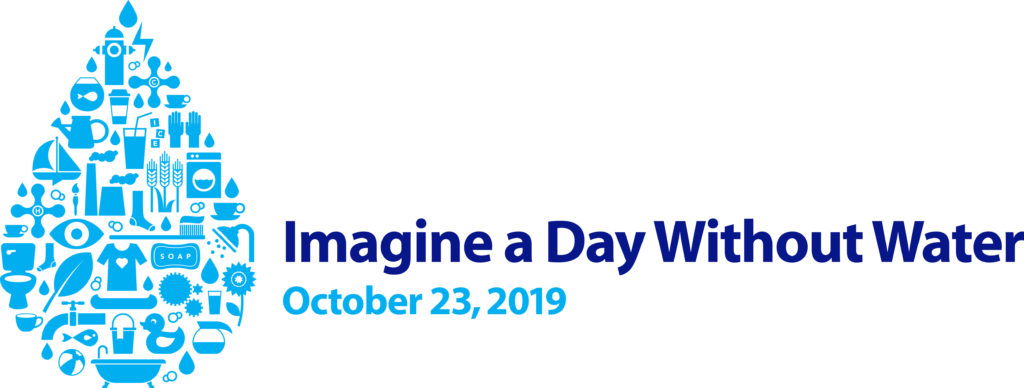
Millions of Americans take water service for granted every day. Turn on the tap, and clean water flows out. Flush the toilet, and dirty water goes away. With reliable water service, people don’t have to think twice about the infrastructure that brings water to their homes, and then safely returns water to the environment – but everyone should be concerned with the fragility of those systems.

Today, the Funders’ Network for Smart Growth and Livable Communities (TFN) joins elected officials, water utilities, community leaders, educators, and businesses from across the country as part of the fifth annual Imagine a Day Without Water, a nationwide day of education and advocacy about the value of water. Led by the Value of Water Campaign, a thousand organizations across the country will raise awareness about not taking water for granted and the crucial need for investment in our nation’s water systems.
Imagine a Day Without Water began in 2015 as a project of The Value of Water Campaign. In 2018, more than 1,000 organizations signed up to participate in the annual day of advocacy and education, including several TFN member organizations.
The Value of Water Campaign educates and inspires the nation about how water is essential, invaluable, and in need of investment. Spearheaded by top leaders in the water industry, and coordinated and staffed by the US Water Alliance, the Value of Water Campaign seeks to build public and political will for investment in America's water infrastructure.
On Imagine a Day Without Water, the campaign asks us to take a moment to think about what would happen if you couldn’t turn on the tap and get clean drinking water, or if you flushed the toilet and wastewater didn’t go anywhere. What would that day be like? What would firefighters do? Could hospitals be sanitary without clean tap water, or without wastewater service? Would restaurants and hotels be able to serve guests? Would famers be able to water their crops or care for their livestock? Would manufacturing plants that require vast amounts of clean water, such as breweries or paper mills, shut down?

We take for granted that we don’t have to ask those questions every day, but America’s water infrastructure is aging and failing. Stories of communities with neglected infrastructure and compromised drinking water bubble up regularly. Record rainfalls in the Midwest this spring flooded the Mississippi River with pollution, and this summer toxic algae bloomed in the Great Lakes – a critical source of drinking water for millions of Americans. In other parts of the country, drought and wildfires threaten critical water supplies for communities and farmers. There are even communities, especially in many rural places across the country, that have never had access to infrastructure in the first place. Americans can’t take their water infrastructure for granted.
Water infrastructure is the lifelines of our community. Our water infrastructure supports every facet of our daily lives, but our water infrastructure is facing challenges.
Equitable access to clean water, as well as approaches to water management that address the urgency of climate change and other sustainability challenges, are issues with deep resonance among many of our TFN members and the communities and constituencies they serve.
TFN is committed to inspire, strengthen and expand philanthropic leadership focused on creating environmentally sustainable, socially equitable and economically prosperous regions and communities.
Next month, TFN’s Urban Water and GREEN working groups will co-host an annual meeting in New Orleans, an ideal location to bring together the combined interests of funders engaged with these working groups, especially given the important work underway in the city and region to address water, climate, equity and sustainability challenges.
The meeting of TFN’s Urban Water and GREEN — which stands Green, Renewable, Efficient, Equitable Now — working groups takes place Nov. 13-14 in New Orleans.
The meeting agenda, being designed by a planning committee of funders, will deepen learning from place and from peers addressing key cross-cutting themes of Power, Equity, and Climate Resilience.
On Wednesday, November 13, the meeting will offer a full day of immersion into work underway in New Orleans and the larger region to mitigate and adapt to climate change and sea level rise in ways that build community voice, power and leadership, as well as partnerships across sectors.
On Thursday, November 14, funders will discuss how lessons from the New Orleans region can inform their own grantmaking strategies around climate mitigation, resilience, green stormwater infrastructure, and sustainability, and identify opportunities for further joint learning and collaboration. Thursday’s agenda will build in time for each of the two working groups to meet individually to catch up on workplan activities.

TFN's GREEN and Urban Water funders will convene in New Orleans in November for a joint annual meeting,
For registration and other information on the GREEN and Urban Water Annual Meeting, visit this link.
For more information on the Value of Water Campaign, follow them on Twitter and Facebook.
Editor’s Note: A portion of this post originally appeared as resource material provided by the Imagine a Day Without Water campaign.
To Transform Bus Networks, Understand Networks of Power
By Steven Higashide, TransitCenter
This post by Steven Higashide, director of research for TFN member TransitCenter, originally appeared on Streetsblog USA:
In forthcoming book, “Better Buses, Better Cities” (Island Press), transit expert Steven Higashide argues that bus transit should the linchpin for fair and vibrant American cities. By reaching into transit deserts and connecting our most vulnerable citizens to jobs and opportunities, bus networks can transform languishing neighborhoods and mitigate the effects of sprawl. Too often, however, those in power ignore this vital form of transit in favor of glossier, attention-getting projects (like ferries). Or they are downright hostile to important infrastructure, such as dedicated bus lanes. In the following article, which is adapted from the book, Higashide provides a road map for activists seeking to build support for buses. Higashide, the director of research at the Transit Center in Manhattan, will speak there about the book on Oct. 15."
Americans take 4.7 billion trips a year on publicly run buses. Yet most decision-makers barely give buses a second thought. Across the country, public agencies that deliver bus service are run by board members who never use it. Some large cities don’t even employ anyone dedicated to improving trips for bus riders. Business leagues, community foundations, and civic leaders often focus on streetcars, hyperloops, driverless vehicles, and other projects they view as more prestigious or likely to drive development.
Others actively try to stop bus improvements, such as business owners who fight bus shelters that they claim attract “the wrong element,” legislators who ban bus-only lanes on state roads, and Congress members who try to cut federal transit funding every year.
This combination of indifference and hostility leads to a neglect that makes so many bus trips miserable: plodding, unpredictable, uncomfortable, and circuitous. Bus speeds have fallen as city traffic gets worse; bus routes that haven’t changed in decades have become less relevant as job centers change; new transportation modes provide alternatives for those who might otherwise take the bus.
In many cities, the bus system has stood still, even as streets, neighborhoods, and the marketplace have been transformed. No wonder, then, that U.S. bus ridership has experienced a lost decade, falling by 17 percent from 2008 to 2018.
It doesn’t have to be this way
In defiance of the national trend, bus ridership has grown in cities as different as Houston, Columbus, San Francisco, Seattle, and Indianapolis. These places share a key similarity: Their leaders have taken forceful action to improve bus service. In these and in many other cities, a rising generation of activists, planners, and elected leaders have recognized the power of better bus service to offer affordable mobility and connect citizens with jobs, schools and healthcare.
They have redrawn bus networks to emphasize frequent routes and redesigned streets to put bus riders first. They have created safer walking connections, built dignified places for people to wait for buses, and changed fares so that transit better serves the people who need it most.
In every American city where buses improve, it has happened only through the efforts of reformers working in concert inside and outside of government. That’s because the big barriers to better bus service are not technical or technological — they’re political and institutional.
Who needs to step up?
In an ideal world, responsive politicians and public servants would simply recognize that cities need more and better transit and would deliver it. But broken politics and planning practices repeatedly deliver the wrong results. Formal public engagement tends to privilege more organized and wealthier residents, and informal networks of power reinforce that tendency. In many cities, buses and the people who ride them have been ignored for so long that it takes a fight just to get on the public agenda.
For these reasons, it’s often civic activists who get the conversation started: grassroots volunteers, community organizations, progressive philanthropists, or even business groups who see the link between better buses and bigger labor pools.
In Miami, the organization Transit Alliance has used data, graphic design, and storytelling to reset journalists’ understanding of transit and force politicians to focus on the bus system. The LivableStreets Alliance collected rider stories for weeks to convince the City of Boston to open its first new bus lane in years. In Indianapolis, the Indy Chamber joined forces with progressive faith-based activists and a tea-party mayor to win higher taxes for transit.
To win better buses in more cities, we need more wonky transit blogs, more faith-based organizing, more riders’ unions, and more state budget watchdogs. Local foundations that care about climate change, wealth inequality, and social inclusion must work for more sustainable and equitable public transit.
Strong public agency leaders are essential: In places where transit has improved, public agency leaders were nimble, strategic, and willing to discard the by-the-book practices and processes that hamstring change efforts.
Agencies must do better than “open houses” that draw eight people at the library — and instead get public input that equitably represents bus riders and activates allies throughout the planning process. They must discard ponderous project development processes that result in five-year timelines for bus-lane projects and try tactical approaches that change streets overnight, as Boston-area municipalities have done in recent years.
Delivering better bus service requires public agencies with enough planners to maintain a constant pipeline of transit-improvement projects, enough dispatchers to keep buses on time, and enough communications and outreach staff to bring transit riders’ and stakeholders’ voices into the conversation.
What can be done?
Once there’s a strong political consensus behind better buses, reformers must turn their attention to how an agency’s structure, capacity, processes, and metrics affect its ability to deliver better transit.
This might mean updating an agency’s street-design manual, or the metrics it uses to judge a project’s success. It might mean replicating King County Metro’s in-house speed and reliability unit, a nine-person team that at, at any given time, is working on 20 “spot-improvement” projects to speed buses through intersections. It might mean hiring more dispatchers, or public outreach staff. All of these help create a transit-supportive status quo at public agencies and ensure that future administrations can’t undo the hard work of reform.
“[We] are obsessed with the City of Boston’s hiring process,” Stacy Thompson of the advocacy group LivableStreets Alliance told me. “We want to understand who they’re hiring, what the roles are, and what is the process for project deployment. We get in the weeds; I know we sometimes annoy them. But unless you care about it at that level, you’re going to keep getting one-off projects.”
What are the pitfalls?
Buses can improve quickly. Every major city in America has streets where, if the bus were made more convenient, transit agencies would reap a bumper crop of new riders. But most cities aren’t moving fast enough to realize this potential.
Soon after Chicago Mayor Rahm Emanuel took office in 2011, he promised a network of BRT routes across the city; after seven years, the city had built only four miles of bus lanes. Transit planners in Washington, D.C., have been discussing the need for a bus lane on 16th Street NW since the early years of the Obama administration; a lane may finally appear in 2020.
Rapid, sustained transportation change rarely happens without an alliance between creative, fearless, independent advocates; politicians willing to stand up for transit; and visionary bureaucrats who can communicate transit’s value in ways that inspire members of the public and potential political allies.
We need a transit conversation that is large enough to include process and politics, not just technology and policy. Journalists, pundits, and analysts have repeatedly discovered that the bus is a solution to urban transportation problems that is hiding in plain sight. In 2013, Slate’s Matthew Yglesias implored cities to “get on the bus.” In 2017, CNN reported that “cities realize they must fix the sorry state of buses.” The following year, Laura Bliss launched a series in CityLab on buses with the motto, “Love the Bus, Save Your City.”
It seems simple. Yet, the fact that the same article keeps being written shows that it is anything but simple. Reformers must think deeply about transit networks (and how to plan them effectively) and the networks of power (and how to navigate them successfully). To achieve change, you have to understand both.
Read the original post on Streetblog USA here.
About the Author
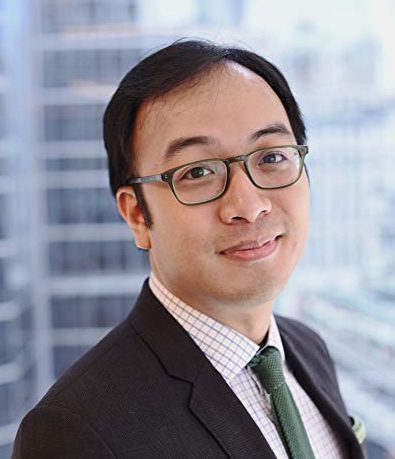
Steven Higashide, director of research at TransitCenter, manages national research focused on what transit riders want, and how cities can build transit-supportive streets and neighborhoods.
He’s the author of several influential TransitCenter reports, including All Transportation is Local and Who’s on Board 2016.
He holds a B.A. from New York University and a Masters in Urban Planning from NYU’s Wagner Graduate School of Public Service.
Feature image: Streetsblog USA
Funders Together to End Homelessness Responds to Federal Intervention on Homelessness
Reposted from Funders Together to End Homelessness
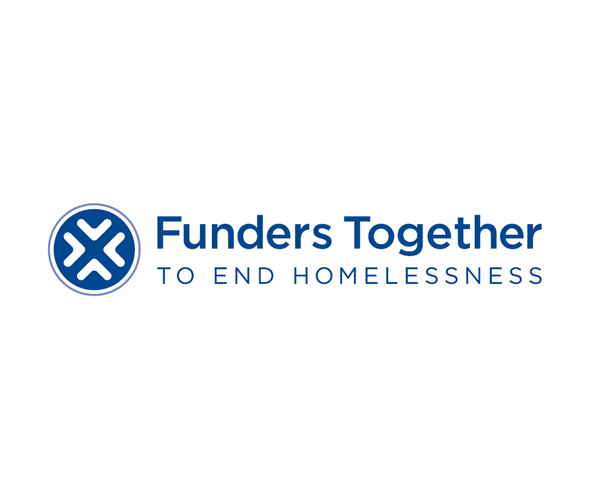
Funders Together to End Homelessness, a national network of funders supporting strategic, innovative, and effective solutions to homelessness, recently issued a response to the White House Council of Economic Advisers "The State of Homelessness in America" report and proposed federal intervention on homelessness in Los Angeles. This post originally appeared on their blog.
Recently, news of the Trump Administration’s plan to “address homelessness” in California spread quickly in the field, causing concern and alarm. Then, on Monday night, the White House’s Council of Economic Advisers released “The State of Homelessness in America” which outlines troubling actions the Administration is proposing as a solution.
Given this report and the other attacks on communities who are historically marginalized like through the Department of Housing and Urban Development’s proposed “mixed status” families rule, changes to the Equal Access Rule, and the public charge, we know the approach and method that will make up this federal intervention are not evidenced-based, ethical, or equitable, and it will not solve homelessness in Los Angeles or other communities facing the same challenges.
Homelessness is a crisis in our country. It isn’t a new one, but it is growing. Not because current solutions to homelessness aren’t working, rather the solutions can’t keep up with the inflow from the root causes of homelessness like the increasing lack of affordable housing, continually stagnant wages, and racial inequities in housing. While in the report the Administration claims it wants to address the root causes of homelessness, there is a clear misunderstanding of homelessness, its contributing factors, and appropriate responses. Using the federal government’s resources to “warehouse” people or utilizing public safety officials to reinforce harmful policies isn’t effective because it won’t address the causes of this crisis and may, in fact, exacerbate it.
Private philanthropy and the federal government are both investors in the community. And as investors, we are also partners. Together, it is crucial to think about how we can engage in meaningful partnerships to support solutions that address root causes, show compassion, and prioritize the care of people. We know what works: access to safe and affordable homes. Housing is the answer to housing instability and homelessness. That is a proven, evidence-based fact and there are supported models already in place that are working in communities across the country. We’ve seen the power of public-private partnership in cities like Los Angeles, and how initiatives can be effective when funders and local leaders who know the community best collaborate and respond to what residents need.
Philanthropy is ready to collaborate with our federal partners through effective and intentional public-private partnerships, as well as provide support to our community advocates to ensure those in need have access to a safe and affordable place to call home. It is committed to working with local and federal partners to support evidence-based models and approaches that prioritize access to affordable housing, centering people with lived expertise, and compassion. Philanthropy will continue to work to ensure solutions are implemented with a racial equity lens in order to end racial disparities in housing and homelessness.
“Philanthropy has invested in, not only solutions to end homelessness, but the evaluation and research of those solutions to better understand what works and what does not,” said Amanda Andere, CEO of Funders Together to End Homelessness. “We need our federal partners to continue to work with us to support to best practices and not revert to policies that we know are ineffective and inhumane.”
Supporting Rural Community Vision
By Allen Smart, Project Director for Rural Philanthropic Analysis at Campbell University and Founder, PhilanthropywoRx
TFN’s Intermountain West Funder Network is a regional network that seeks to inspire, strengthen and expand funding and philanthropic leadership in the Intermountain West that engages people in decisions that result in more environmentally sustainable, socially equitable, and economically prosperous regions and communities. For its tenth annual convening in Colorado Springs and nearby Manitou Springs, Col., IMWFN invited rural philanthropy expert Allen Smart as its closing keynote speaker. Allen also facilitated a conversation with IMWFN attendees. We asked him to share his insights and experience with the broader TFN audience.
Most of the participants in the Intermountain West Funder Network are inherently funders of rural work. Given the geography of the states represented by members, there isn’t a choice. A new generation of place-focused philanthropy, however, emphasizes how funders can partner with rural communities to work on the big long-term challenges as defined by the communities themselves. This key difference in approach — shifting from a responsive funder of rural projects to an intentional rural and small-town funder — has great potential to support the kind of community-sustained work that funders wish for but don’t often witness.
In April 2019, I facilitated a panel of Intermountain West funders committed to engaging with rural and small towns in ways that reflect many of the practices that I have collected over my 20-plus years leading and studying rural philanthropy around the country. David Leckey from the Orton Family Foundation, LaMonte Guillory with the LOR Foundation and Dr. Ned Calonge with The Colorado Trust all shared a similar perspective on finding the best ways to bring a big toolbox of foundation assets to their small and rural towns. While each foundation has distinct language and process, all the panelists stressed the need for:
- - On-the-ground, long-term relationship with their rural communities;
- - Flexibility in setting priorities, recognizing the best choices lie within those communities;
- - Engaging folks well beyond the sphere of non-profit and civic leaders.
These strategic choices all recognize the commonality of good rural philanthropic practice while creating space for work that is sustainable before, during and after grant funding.
Over the past two years, I have had the privilege of taking a look at rural philanthropy around the country and writing and presenting my observations to funders, rural advocates and the philanthropic and rural media. I have never been more optimistic about the work of rural-serving foundations. The leadership of funders in the rural space has never been more connected to community. On a cautionary note, however, I fear that the interest in rural issues by some larger funders — both public and private — may be similar to the flurries of activity we’ve seen in decades prior: temporary and plagued by a disconnect from community and lack of understanding of rural culture.
The theme of the Funders’ Network 2020 Annual Conference in San Diego is “Bridging the Divide.” This is a perfect platform for funders to intentionally learn with each other about the inherent connectivity between urban, suburban and rural communities in their service geographies. With few exceptions, all rural communities are connected to some place that they think of as the big town or the small city. A recent Washington Post story quoted a 2018 article in the Journal of Applied Economic Perspectives and Policy indicating that 60 percent of people who consider themselves rural actually live in a statistically defined urban area.] That’s many more people than the 60 million that we normally use as a base number to represent the rural population of the country. Once again, while funders may not consider themselves rural-serving, funders are touching the lives of many who consider themselves rural.
The opportunities for funders to develop their rural skills and interests are increasing at a rapid pace. In addition to TFN’s Intermountain West Funder Network, many national groups like the Neighborhood Funders Group and Grantmakers in Aging have specific rural initiatives to support their member’s interests. State grantmakers groups in states like Colorado, Minnesota and Texas are addressing rural issues. Check with your state and national affiliations for participation opportunities. Importantly, connect with the local or regional representatives for your local federal agencies like the USDA, Office of Rural Health Policy, Rural HUD and your regional EPA and Federal Reserve. All have new or enhanced rural platforms that provide partnership opportunities and learning for funders and your communities.
If you have been in the rural philanthropic space for years, we thank you! For those who are just starting, there are plenty of people who want to support you. Learn from those who have gone before.
About the Author
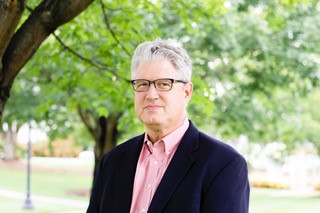
Allen Smart, Project Director for Rural Philanthropic Analysis, Campbell University
Allen is a national spokesperson and advocate for improving rural philanthropic practice under his group – PhilanthropywoRx. In addition, he recently completed a role as the Project Director for a national rural philanthropic project partially supported by the Robert Wood Johnson Foundation and based at Campbell University in Buies Creek, North Carolina. He regularly consults with regional and national foundations on rural and philanthropic strategy.
As part of his personal and professional interest in philanthropy, Allen regularly writes for sites such as The Daily Yonder, Inside Philanthropy, Grantcraft and Exponent Philanthropy, as well as presenting to national and regional organizations like Grantmakers in Health, Southeastern Council of Foundations, National Rural Assembly and the federal Office of Rural Health Policy. He is a member of the National Advisory Committee for the Rural Resource Hub at The University of North Dakota; the Culture of Health Prize Selection Committee for Robert Wood Johnson Foundation, Board of Directors for Healthy Communities by Design and the Board of the North Carolina Healthcare Association Foundation.
Community Change Learning Exchange: Frank talk for foundation leaders and staff
By: TFN Staff
Save the date for this year's Community Change Learning Exchange (CCLE), a forum for foundation leaders and staff to engage in frank discussions about the opportunities and challenges associated with place-based community change. CCLE's aim is to promote honest dialogue about the realities of undertaking place-based work and what funders might do differently to ensure the equitable, long-term viability of community change work.
A central assumption of CCLE is that the purpose of community change is to dismantle the underlying systemic and structural conditions that perpetuate disparity and disinvestment in low-income neighborhoods and communities of color.
This year, CCLE will take place Dec. 4-6 in Montgomery, Alabama.
What are the desired outcomes?
We hope that learning, sharing and challenging one another through authentic “safe space” conversations on our respective work in place-based community change enables us to:
• Capture, cull and disseminate the best practice lessons to the field of place-based community change
• Glean learning opportunities from others in the field for the purpose of informing one’s own place-based community change work
• Advance funder thinking and action to the importance and value of community change work in your own places.
• Advance funder thinking around race and equity and how it connects to community change work in your own places.
How does the CCLE operate?
CCLE aims to provide a means to unlock and share lessons learned, what works, what doesn’t and what still remains to be learned, as well as to create a safe space for funders to discuss not only past, but current challenges they are experiencing in community change work.
The CCLE creates an opportunity for funders to discuss – openly – opportunities, challenges and perspectives in community change work.
We invite you to save the date and stay tuned for more information!
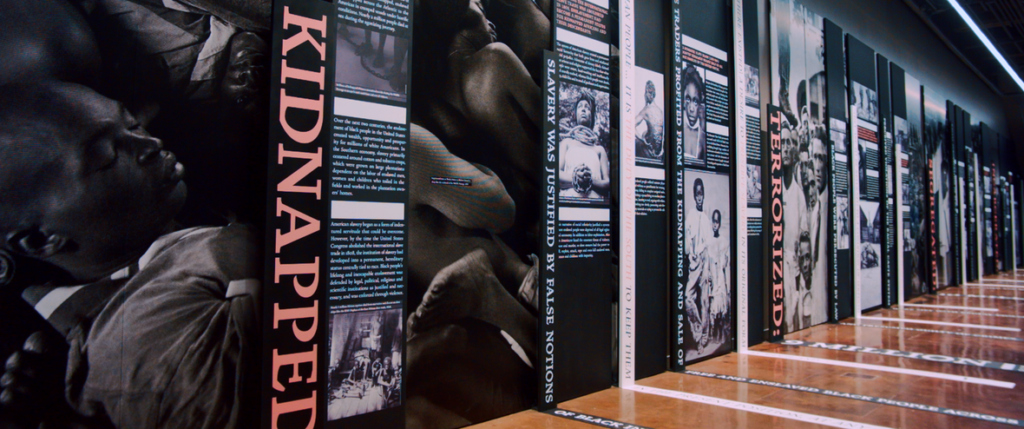
The Legacy Museum: From Enslavement to Mass Incarceration
About Community Change Learning Exchange (CCLE)
The Annie E. Casey Foundationconvened the first CCLE meeting in Baltimore in 2014 and has served as the CCLE convener and executive secretariat, but CCLE is not a Casey initiative. The foundations that hosted the CCLE meetings have been involved in place-based work, including implementing long-term community change initiatives (CCIs). The meeting explored lessons related to community engagement, race equity and inclusion, transparency, mitigating the effects of gentrification and displacement and other essential elements of effective place-based work. Community representatives also participated in CCLE site visits and discussions, allowing foundation representatives to engage with them at a depth that is unusual in many funder-grantee relationships.
CCLE is a vital forum for capturing and sharing knowledge, as well as a community of support for representatives of foundations engaged in placed-based community change. It offers a safe space for discussion and reflection that is hard to achieve when one is immersed in actually doing the work. CCLE augments the work of philanthropic affinity groups concerned with place-based work (all of which participated in CCLE) and provides a platform to inform the field about how to do this important work better. To date, approximately 100 foundation staff and other stakeholders participated in the four CCLE sessions.
The mind reels, the heart aches. But our values are not negotiable.
By Patricia L. Smith, TFN President & CEO
Three mass shootings in less than a week. Two of which involved a shooter who espoused white supremacist views before launching horrific attacks.
Like most of you, I have spent the last several days trying to wrap my head around what we’ve become as a nation. Who we are. Where we’re going.
Nine dead in Dayton, Ohio, after a gunman opened fire on people just looking to hang out at their neighborhood bar.
Twenty-two dead in El Paso, killed by a gunman whose racist manifesto lamented a “Hispanic invasion.”
Three dead at a festival in Gilroy, Calif., shot by a man who promoted white supremacist literature on social media shortly before the attack.
At the time of this writing, there have been 253 mass shootings in America this year, according to the non-partisan Gun Violence Archive. More shootings than days so far in 2019.
The mind reels and the heart aches.
Of course, we know that incidents involving guns have been a plague on America before the current administration — including not just mass shootings, but also deaths by suicide, domestic violence, police-involved shootings and depressingly routine violence that rarely merits more than a 20-second segment on the local news.
And yes, we know that racism and xenophobia likewise predate the current administration — it is impossible to look at our history without considering the taint of slavery, genocide and forced displacement of native peoples, the treatment of immigrants and the legacy of inequitable policies that continue to impact access to everything from clean air and drinkable water to affordable healthcare and decent housing.
We know that there are many people and institutions — including among the membership of the Funders’ Network — who have spent years and decades tackling these very issues.
We know all of this this. And yet it doesn’t lessen the pain and confusion and horror of the past few days. And it doesn’t lessen the grim reality that these shootings may one day fade from our minds.
Don’t believe me? Take a look at this list of the deadliest mass shootings in recent decades and count how many you’ve forgotten. How many have slipped from your memory until you see the names of the city and the death toll once again in black and white?
Maybe this time will be different. We always hope that this time will be different.
I will note that the president’s public statement on Monday — unlike those made in the aftermath of the deadly alt-right protest in Charlottesville — stated that our “our nation must condemn racism, bigotry, and white supremacy.”
But the words read off the teleprompter are in stark contrast to the racist and xenophobic language of his tweets and campaign rallies.
Telling four congresswomen, all women of color, to “go back to where they came from.” Describing the predominately black city of Baltimore as rat-infested and unfit for humans, and leveling jeering broadsides against its African American congressman.
Repeatedly describing immigration as an “invasion” and offering little more than a smirk when a supporter shouts that the best way to deal with illegal immigrants is to “shoot them.”
Words matter, to say nothing of actual policies — enacted or envisioned — that desecrate the environment, separate families and undermine our faith in civic institutions.
The most recent barrage of divisive statements tap into some of the oldest and most pernicious of racists tropes: That the color of your skin, the origins of your last name, or the place where you — or your parents, or your grandparents — were born, makes you less than. Less of an American. Less of a human.
These comments come after months of escalating, hard-line policies and toxic rhetoric that have contributed to a humanitarian crisis at our borders; deplorable conditions at centers where men, women and children seeking refuge are held; efforts to pose a citizenship question on the U.S. Census that could have resulted in a drastic undercount of immigrant communities; and ongoing confusion about whether immigrants and asylum-seekers will be afforded due process guaranteed to them under the law.
The drumbeat of vitriol directed at black and brown people, including migrants seeking refuge at our borders, erodes trust in our communities.
Over the past year, we have heard chilling reports from across our network about how these inhumane actions and attitudes have further isolated a vulnerable population — including a sharp decline in reports of sexual assaults and other serious crimes against immigrants and refugees because victims are distrustful of local authorities and a hesitancy to send children to school or report for work because of fears of being detained.
We saw this in El Paso, where some victims of the shooting were reluctant to seek aid because they feared detention or deportation based on their immigration status.
We are seeing this firsthand in South Florida, which is home to a thriving and diverse community of immigrants from across the world.
South Florida is also home to TFN’s main office, where the majority of our staff are either immigrants or first-generation Americans.
I stand with them, and the rest of the TFN family, in rejecting the racist and xenophobic language that has recently dominated public discourse and continues to poison political debate.
TFN was founded 20 years ago as a non-partisan organization committed to helping create communities that are sustainable, prosperous and just. But non-partisan does not mean that our values are negotiable.
As an organization, we state unequivocally that for communities to truly thrive, those communities must fully embrace and engage all those that have been historically marginalized because of their race, gender, sexual orientation, religion or cultural background — including immigrants, descendants of enslaved people and members of indigenous communities.
As leaders in philanthropy with deep ties to the places you serve, you are uniquely positioned to speak out against intolerance, stand up for the less fortunate and work towards creating communities that are compassionate and just.
To those of you whose foundations are doing this work: Keep at it.
Share what you’re doing and what you’ve learned with us, so that we can in turn amplify those lessons across the network. We are committed to providing a place for our members to come together to share their learning and devise the strategies that will help achieve those goals.
To those of you whose foundations are just beginning to articulate and fight for the values of equity and inclusion — and to those of you who are facing obstacles in even starting those often uncomfortable conversations: Don’t give up.
We’re here for you and are committed to helping our members access the tools and learning they need to turn ideals into impact.
As many of you know, our 2020 Annual Conference will take place March 16-18 in San Diego, which like El Paso is a border town. Our time in San Diego will present an opportunity for funders to reflect and learn about life on the border, including not just the challenges but the rich cultural history of the city as well. Our conference theme — Bridge the Divide — is a challenge to examine and confront the barriers to opportunity, empowerment and justice for all.
As I look across our diverse network of funders and partners, I see people working in communities that span that from coast to coast, from small towns and rural areas to metropolitan cities and their suburbs.
And I see the tremendous potential that can come when we harness our good intentions and leverage our collective resources for the betterment of all.

How to Help
The Dayton Foundation has established an Oregon District Tragedy Fund for the victims’ families.
The El Paso Victims Relief Fund, organized in part by the Paso Del Norte Community Foundation.
The El Paso Community Foundation is also accepting donations for victims of the shooting.
The American Red Cross is accepting donations online.
Public Good has launched a fundraiser benefiting Dayton and El Paso victims.
Responses from Leaders in Philanthropy
Below is a roundup of recent statements from leaders in the sector speaking out against racism and xenophobia. Please contact TFN Director of Communications Tere Figueras Negrete if you would like to have a statement added to this list.
Chronicle of Philanthropy: Philanthropy Reacts on Social Media to Mass Shootings in El Paso and Dayton
Kiran Ahuja, CEO, Philanthropy Northwest: Philanthropy Leaders, Join Me in Rebuking Trump’s Racist ‘Go Home’ Tweets
Fred Blackwell, CEO, San Francisco Foundation: Battle the Bully Pulpit, Right Here at Home
Jim Canales, President & Trustee, Barr Foundation: We Must Persevere
Don Howard, President and CEO, The James Irvine Foundation: Standing up to divisiveness, providing aid for immigrant families
Grant Oliphant, President, The Heinz Endowments: It's Time to Bring Back America's Noble Impulses
Rip Rapson, President and CEO of The Kresge Foundation:A ‘problem solver’ president could turn Baltimore around, like Obama did for Detroit
Shanaysha Sauls, President and CEO, Baltimore Community Foundation: Statement on President Trump's Tweets about Baltimore
About the Author
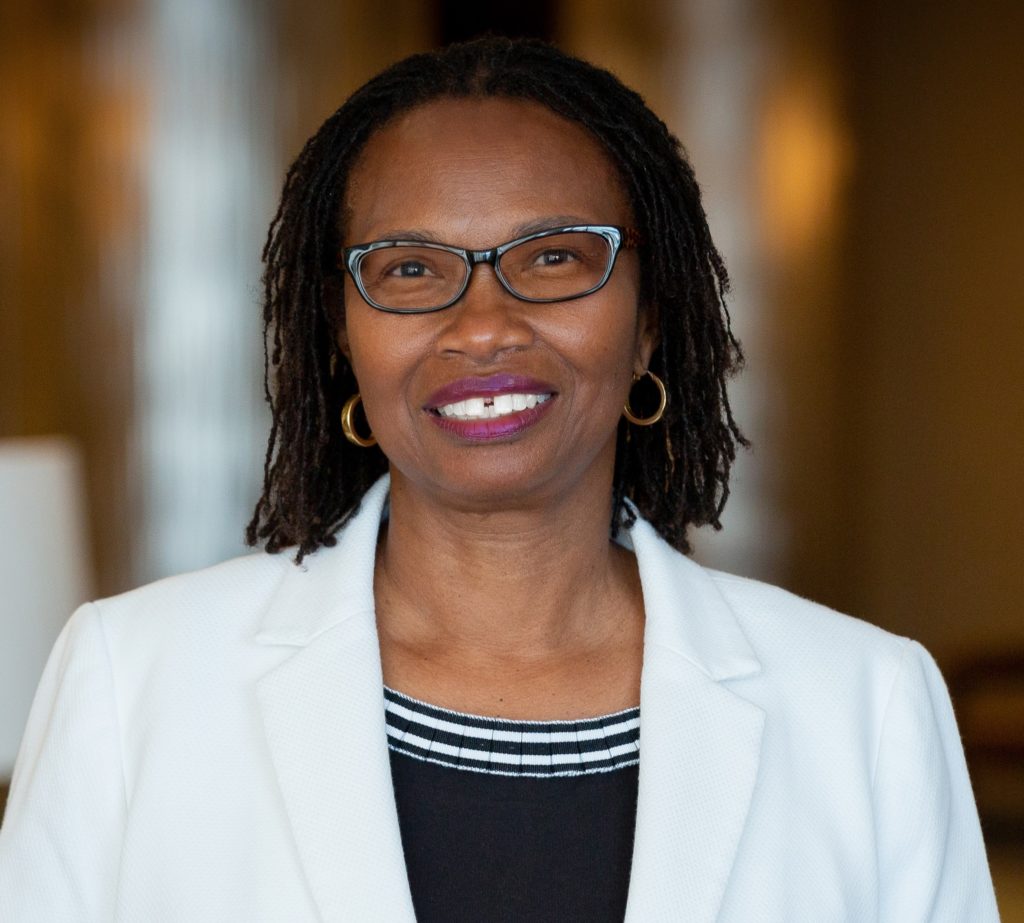
Pat joined the Funders’ Network in July 2018 as president and CEO, bringing with her a wealth of expertise in the public, private and nonprofit sectors. She is formerly a senior policy advisor for the Reinvestment Fund, a national leader working to rebuild economically-distressed communities through the strategic and innovative use of capital, data and partnerships. Read her full bio here.
SAVE THE DATE! Inclusive Economies 2019 Inaugural Meeting
By TFN Staff
The Funders' Network invites all national and place-based funders to join us for the Inclusive Economies working group's inaugural annual meeting November 4-6 in Cleveland, Ohio.
Inclusive Economies (formerly the Restoring Prosperity in Older Industrial Cities working group) focuses on race, place, and power-building in creating shared, equitable, and restorative prosperity for all. This new group welcomes funders working in places of all market types, size, and characterurban, suburban, and rural) to participate.
Stay tuned for more details!
About Inclusive Economies
The Inclusive Economies program convenes an annual meeting, hosts topical webinars, organizes sessions at TFN’s annual conference, and supports a funder working group listserv. IE staff also publishes a Friday Resource Roundup, which shares recent news, articles and resources related to race, inclusion, and place-based economic prosperity. For more information and to sign up for the roundup, email Alicia Kitsuse at alicia@www.fundersnetwork.org.
